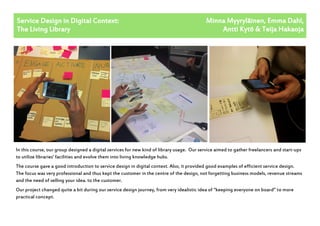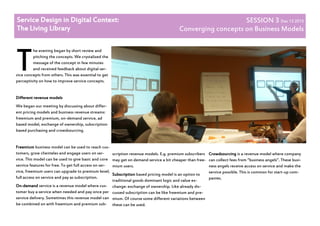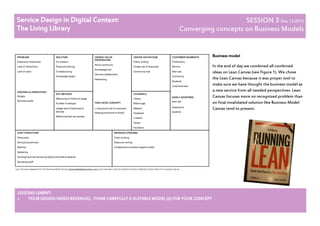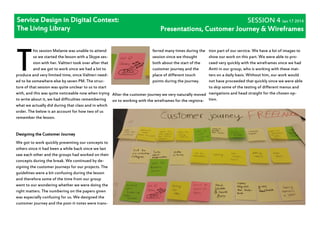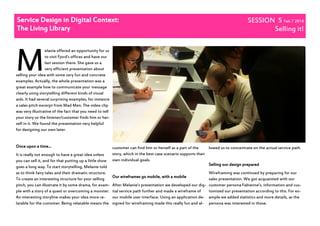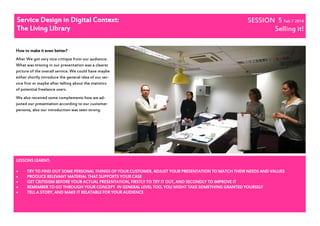Living Library_project
- 1. Service Design in Digital Context: The Living Library In this course, our group designed a digital services for new kind of library usage. Our service aimed to gather freelancers and start-ups to utilize librariesŌĆÖ facilities and evolve them into living knowledge hubs. The course gave a good introduction to service design in digital context. Also, it provided good examples of efficient service design. The focus was very professional and thus kept the customer in the centre of the design, not forgetting business models, revenue streams and the need of selling your idea. to the customer. Our project changed quite a bit during our service design journey, from very idealistic idea of ŌĆ£keeping everyone on boardŌĆØ to more practical concept. Minna Myyryl├żinen, Emma Dahl, Antti Kyt├Č & Teija Hakaoja
- 2. Service Design in Digital Context: The Living Library O ur journey started before our first meeting with the pre task where we compared digital and physical offer- ings from the same service and with that we got to think about what kind of experiences we can create digitally and physically. On our first contact session, we got introduced into digital service design, why we need that and what that means. We also went through our course con- struction, and we got some overview of what we are going to do along our way. We were divided into small groups for to create new digital service dur- ing our course one piece at a time, and the idea was to learn by doing. Concerning Libraries Before we started to work on group assignment we continued comparing physical and digital services, and we explored different kind of touch points to- gether. We started our ideation part by choosing the industry to work with from the pre tasks what we had done. Each of us presented shortly what was the industry on our tasks. We decided to do this service for library. We chose the library because two of us had made the pre task from that industry. Library was also interesting for all of us because they really need to change a lot in the future and create new services for their customers to keep them active and to get new customers, as well. After that, we started ideation, and we got some trend cards for to basis of our new service. Our group chose trend card Co-creation Slow living with description "People are becoming more con- scious of the role that time plays in shaping life quality. They are prioritizing experiences, connec- tion with others, health, holistic well-being and cre- ativity in place of speed and pace of life." The ideation begins Then was time to start brainstorming and we start- ed to think what kind of needs people have. We got ideas that our service could help people to find other people who share the same interest than they. We also talked a lot of how we could help senior citizens active part of the society and to help them to find new friends for prevent them to be- come lonely. Addition to seniors we thought about unemployed and how library could activate them too. Other view was that how we could create library more interesting place for citizens and help them to keep their customers on board and also to get new visitors. We knew that libraries have changed their environment quite much lately, and they have add- ed more services in some places and we tried to SESSION 1 Sep 13 2013 A well designed start
- 3. Service Design in Digital Context: The Living Library invent something new. This would be something which would combine both physical and digital touchpoints. Keep everyone on board @library In the end of the day, we end up with the new con- cept idea named "Keep everyone on board @library" and we draw a picture which looked like a Noah's ark. Our poster was like a notice board where we had different types of notices where peo- ple were looking for help or providing help to each other. That picture was presenting our idea to give something for the whole community. SESSION 1 Sep 13 2013 A well designed start LESSONS LEART: ’éĘ LOOKING AT TRENDS CAN EASE YOUR DESIGN PROCESS BY GIVING LONG-TERM PERSPECTIVE ’éĘ USING A TIMER HELPS RAPID IDEATION, CREA- TING MORE IDEAS, AND LESS CRITISISM ’éĘ HAVING AN IDEALISTIC CONCEPT DOESNŌĆÖT HURT
- 4. Service Design in Digital Context: The Living Library D uring this second session, we went fur- ther with our plans for the new kind of Library. We talked about designing the service but also about founding a relationship with the customer. During this evening, we had many sketches to fill out so our group didnŌĆÖt have time to complete them all during the evening, but we continued the work after class. Please see the attached images for a summary of our work. The crucial touchpoints that deliver the service The service touchpoints are all the little interac- tions that happen between the service provider and the customer experiencing the service. The service touchpoints are crucial interactions, where many things can go wrong. Your task as a service provider is to lead your customer through the touchpoints in a successful way. To start with, someone in class put it nicely: ŌĆ£Tell your motherŌĆØ. This refers to the skill of ex- plaining something complex in an easy manner. Your offering should be easy to understand and you should focus on designing a ŌĆ£hookŌĆØ, and doing that hook really well. Touchpoint strategy is all about when you present which kind of information or re- quirements. Your service should be easy to get started with so therefore it is of value that you think about which kind of information is crucial to start with. Gaming dynamics are an easy way of making a service easily approachable. SESSION 2 Nov 8 2013 Service Touchpoints and Touchpoint strategy
- 5. Service Design in Digital Context: The Living Library WhatŌĆÖs your relationship status? We also discussed building customer relationships during class. Melanie presented Fjord┬┤s nice com- parison of customer relationships to how real rela- tionships develop. Melanie showed three different stages for this: matchmaking, dating and truelove. The matchmaking is really about discovery, you stumble into something interesting and you want to learn more. The dating phase is about trial and ex- periencing some kind of wow-effect when you real- ly start to deepen the relationship. The truelove sig- nifies loyalty to a service ŌĆō this is the time when you realize just how important that service is and you experience a sense of ŌĆ£of courseŌĆØ when you think about the service. The templates given by Melanie during this session were really useful. We also liked the comparison of a customer relationship to a real-life relationship. As mentioned earlier, this session was a lot to take in and we had to continue the work after our ses- sion. We met again before the third session to go through the material and at this point our original concept evolved quite much. SESSION 2 Nov 8 2013 Service Touchpoints and Touchpoint strategy
- 6. Service Design in Digital Context: The Living Library Changes on the way We started to think more about who could be our early adopters and we end up to freelancers and in that way to small start-ups who would need space to work and networks around them. The library could help them by providing premises and devices for them and freelancers could help each others by cooperating and co-creating. The library would also be the information provider naturally and share the knowledge. The library would get free marketing when freelancers would spread the word about this service in social media. SESSION 2 Nov 8 2013 Service Touchpoints and Touchpoint strategy LESSONS LEART: ’éĘ YOU NEED TO BE ABLE TO EXPLAIN YOUR IDEA VERY SIMMPLY, THINK ABOUT EX- PLAINING IT TI YOUR MOM OR GRANDFA- THER ’éĘ TO START USING THE SERVICE SHOULD BE DESIGNED SUPER EASY ’éĘ DESIGN YOUR TOUCHPOINT S TO EN- FORDE THE CUSTOMER RELATIONSHIP
- 7. Service Design in Digital Context: The Living Library T he evening began by short review and pitching the concepts. We crystalized the message of the concept in few minutes and received feedback about digital ser- vice concepts from others. This was essential to get perceptivity on how to improve service concepts. Different revenue models We began our meeting by discussing about differ- ent pricing models and business revenue streams: freemium and premium, on-demand service, ad based model, exchange of ownership, subscription based purchasing and crowdsourcing. Freemium business model can be used to reach cus- tomers, grow clienteles and engage users on ser- vice. This model can be used to give basic and core service features for free. To get full access on ser- vice, freemium users can upgrade to premium level; full access on service and pay as subscription. On-demand service is a revenue model where cus- tomer buy a service when needed and pay once per service delivery. Sometimes this revenue model can be combined on with freemium and premium sub- scription revenue models. E.g. premium subscribers may get on demand service a bit cheaper than free- mium users. Subscription based pricing model is an option to traditional goods dominant logic and value ex- change: exchange of ownership. Like already dis- cussed subscription can be like freemium and pre- mium. Of course some different variations between these can be used. Crowdsourcing is a revenue model where company can collect fees from ŌĆ£business angelsŌĆØ. These busi- ness angels receive access on service and make the service possible. This is common for start-up com- panies. SESSION 3 Dec 13 2013 Converging concepts on Business Models
- 8. Service Design in Digital Context: The Living Library Business model In the end of day we combined all combined ideas on Lean Canvas (see Figure 1). We chose the Lean Canvas because it was proper tool to make sure we have thought the business model as a new service from all needed perspectives. Lean Canvas focuses more on recognized problem than on final invalidated solution like Business Model Canvas tend to present. SESSION 3 Dec 13 2013 Converging concepts on Business Models LESSONS LEARNT: ’éĘ YOUR DESIGN NEEDS REVENUES, THINK CAREFULLY A SUITABLE MODEL (S) FOR YOUR CONCEPT
- 9. Service Design in Digital Context: The Living Library T his session Melanie was unable to attend so we started the lesson with a Skype ses- sion with her. Valtteri took over after that and we got to work since we had a lot to produce and very limited time, since Valtteri need- ed to be somewhere else by seven PM. The struc- ture of that session was quite unclear to us to start with, and this was quite noticeable now when trying to write about it, we had difficulties remembering what we actually did during that class and in which order. The below is an account for how two of us remember the lesson. Designing the Customer Journey We got to work quickly presenting our concepts to others since it had been a while back since we last saw each other and the groups had worked on their concepts during the break. We continued by de- signing the customer journeys for our projects. The guidelines were a bit confusing during the lesson and therefore some of the time from our group went to our wondering whether we were doing the right matters. The numbering on the papers given was especially confusing for us. We designed the customer journey and the post-it notes were trans- ferred many times during the session since we thought both about the start of the customer journey and the place of different touch points during the journey. After the customer journey we very naturally moved on to working with the wireframes for the registra- tion part of our service. We have a lot of images to show our work on this part. We were able to pro- ceed very quickly with the wireframes since we had Antti in our group, who is working with these mat- ters on a daily basis. Without him, our work would not have proceeded that quickly since we were able to skip some of the testing of different menus and navigations and head straight for the chosen op- tion. SESSION 4 Jan 17 2014 Presentations, Customer Journey & Wireframes
- 10. Service Design in Digital Context: The Living Library SESSION 4 Jan 17 2014 Service Touchpoints and Touchpoint strategy
- 11. Service Design in Digital Context: The Living Library SESSION 4 Jan 17 2014 Service Touchpoints and Touchpoint strategy LESSONS LEARNT: ’éĘ DESIGNING INTERFACES CAN BE EASILY DONE BY DIVIDING DIFFERENT FEATURES TO INDIVIDUAL STICKY NOTES; IDEAS TEND TO CHANGE AND FIND NEW PLACES ’éĘ ASK SOMEONE TO TRY YOUR DIGITAL SERVICE TO TEST ITŌĆÖS USABILITY
- 12. Service Design in Digital Context: The Living Library M elanie offered an opportunity for us to visit FjordŌĆÖs offices and have our last session there. She gave us a very efficient presentation about selling your idea with some very fun and concrete examples. Actually, the whole presentation was a great example how to communicate your message clearly using storytelling different kinds of visual aids. It had several surprising examples, for instance a sales pitch excerpt from Mad Men. The video clip was very illustrative of the fact that you need to tell your story so the listener/customer finds him or her- self in it. We found the presentation very helpful for designing our own later. Once upon a time... It is really not enough to have a great idea unless you can sell it, and for that putting up a little show goes a long way. To start storytelling, Melanie told as to think fairy tales and their dramatic structure. To create an interesting structure for your selling pitch, you can illustrate it by some drama, for exam- ple with a story of a quest or overcoming a monster. An interesting storyline makes your idea more re- latable for the customer. Being relatable means the customer can find him or herself as a part of the story, which in the best case scenario supports their own individual goals. Our wireframes go mobile, with a mobile After MelanieŌĆÖs presentation we developed our dig- ital service path further and made a wireframe of our mobile user interface. Using an application de- signed for wireframing made this really fun and al- lowed us to concentrate on the actual service path. Selling our design prepared Wireframing was continued by preparing for our sales presentation. We got acquainted with our customer persona FabienneŌĆÖs, information and cus- tomized our presentation according to this. For ex- ample we added statistics and more details, as the persona was interested in those. SESSION 5 Feb 7 2014 Selling it!
- 13. Service Design in Digital Context: The Living Library After quickly sketching our manual slides, we de- cided who would present what in which order. We also discussed how to make the presentation still interesting and story like. Our customer persona was a manager from the li- brary services, with a passion for knowing every de- tail and controlling things. We discussed within our group what these kinds of characteristics could mean in practice, coming to a conclusion that we needed to convince the person of fortifying her sta- tus, having control over the project and making her library the most innovative one. Considering the customerŌĆÖs hidden needs and values was very help- ful for creating the sales presentation. We started our presentation by introducing very shortly our service, and showing the statistics of li- brary usage. We also stated that library funding went hand in hand with the users. We thought this part as convincing the need of the service, a threat or a fairy tale monster that needed actions to pre- vent bad things happening. Secondly we introduced another statistic of start- ups, giving an idea of growing number of a poten- tial new segment that would mean early adapters for the new library concept. We continued by step- ping back a bit, by going through what kind of ser- vices the libraries already had and how to utilize them better. We then introduced very detailed plan of our digital service, including wireframes of both web and mobile applications. SESSION 5 Feb 7 2014 Selling it!
- 14. Service Design in Digital Context: The Living Library How to make it even better? After We got very nice critique from our audience. What was missing in our presentation was a clearer picture of the overall service. We could have maybe either shortly introduce the general idea of our ser- vice first or maybe after telling about the statistics of potential freelance users. We also received some complements how we ad- justed our presentation according to our customer persona, also our introduction was seen strong. SESSION 5 Feb 7 2014 Selling it! LESSONS LEARNT: ’éĘ TRY TO FIND OUT SOME PERSONAL THINGS OF YOUR CUSTOMER, ADJUST YOUR PRESENTATION TO MATCH THEIR NEEDS AND VALUES ’éĘ PRODUCE RELEVANT MATERIAL THAT SUPPORTS YOUR CASE ’éĘ GET CRITISISM BEFORE YOUR ACTUAL PRESENTATION, FIRSTLY TO TRY IT OUT, AND SECONDLY TO IMPROVE IT ’éĘ REMEMBER TO GO THROUGH YOUR CONCEPT IN GENERAL LEVEL TOO, YOU MIGHT TAKE SOMETHING GRANTED YOURSELF ’éĘ TELL A STORY, AND MAKE IT RELATABLE FOR YOUR AUDIENCE

